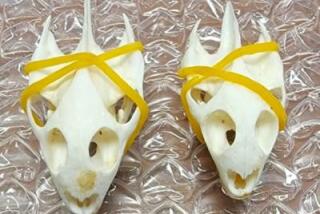Watch Out for Forbidden Souvenirs
- Share via
Buying souvenirs abroad can be trickier than many travelers realize, and sometimes they are disappointed when they can’t bring back some items made of the hides, shells, feathers and teeth of endangered species.
Such items may be confiscated by U.S. Customs, working in conjunction with the U.S. Fish and Wildlife Service, and travelers may be fined by the latter agency if it can be established that they knowingly tried to bring in something not allowed.
“We just had a man with a pair of boots made from sea turtles he bought in Mexico, and he was quite indignant initially about having his expensive boots taken from him,” said Maryann Noonan, a customs spokeswoman. “Sea turtles are an endangered species, and he won’t get that pair of boots back.”
If customs spots something that appears questionable, it will hold it for the U.S. Fish and Wildlife Service, Noonan said. You’ll get a receipt from customs with a line for you to sign indicating your agreement to abandon the item if it is found in violation of laws and regulations covering endangered species.
Items Mailed to Owners
“We pick up such items from the airport once a week and take them to our Gardena office for identification and evaluation,” said Larry Strong, an inspector with the fish and wildlife service. “If the item is OK, we mail it to the person by certified mail or the traveler can come and pick it up.”
If the item is in violation of the rules and you haven’t already signed the abandonment stipulation, you will get another abandonment form to sign from the fish and wildlife service.
“This is usually the end of the matter,” Strong said. “But if people don’t agree to abandonment, then we have an informal hearing. And if they want to pursue the matter further, they can go to court.”
The evaluation is based on three levels of protection for endangered or threatened species, Strong said. Under the first level, items are forbidden entry. Under the other two levels, it may be possible to get the item back if it is for one’s personal use.
“There are different rules and laws which may affect each species,” Strong said.
Customs generally looks at items to see whether they are identifiable as fully protected, Noonan said.
“These items are detained. But if the item is not fully identifiable, which can be the case with reptile skins, for example, and the product was brought in non-commercially and for personal use, we may let it go by.”
Laws, Regulations
A combination of U.S. laws and American participation in the Convention on International Trade in Endangered Species (CITES) regulates what wildlife products may be brought into the country.
The Endangered Species Act prohibits the import (alive or as trophies) and export of more than 700 species of animals and plants.
“This list is always being updated,” Strong said.
The Lacey Act forbids the import of species sold in violation of foreign laws, as many other countries also prohibit or restrict traffic in such items.
The Marine Mammal Protection Act bans the import of marine mammal products, including seals, whales, sea lions, otters, walruses, polar bears, etc.
With all these rules, it’s not easy for travelers to know what can be brought back to the United States.
You can get free copies of a couple of brochures, “Buyer Beware!” and “Facts About Federal Wildlife Laws,” from the U.S. Fish and Wildlife Service, Department of the Interior, 1149 West 190th St., Suite 2024, Gardena 90248, phone (213) 297-0063.
Other Sources of Information
Another source of information is Traffic (U.S.A.), World Wildlife Fund, 1255 23rd St. N.W., Washington, D.C. 20037.
There is a U.S. Fish and Wildlife exhibit covering endangered species, including some examples of prohibited products, at the main boarding area of Satellite 2 at LAX.
Overseas, you can check with a U.S. Embassy or Consulate.
“Even personnel at these offices may not be sure and have to do some research, which is what we often do,” Strong said. “The best rule of thumb is not to buy something if you feel any doubt about being able to bring it to the United States.”
The more exotic the creature the item is made from, the more likelihood of it being under some prohibition. The product may be sold legally in the country you’re in, but despite any assurances by vendors, this doesn’t mean you can bring the item into the United States.
Similarly, be aware that wildlife can be “laundered.” Creatures are illegally killed or collected in one country, then smuggled into another country where it may be legal to sell products derived from them.
“Some travelers don’t know, or pretend not to know, that they’re buying items made from endangered species,” Noonan said. “What they’re doing is sustaining or increasing the demand for these products, which means the species stays endangered or is wiped out.”
Many Products Included
The range of illegal wildlife products, which may be both innocuous looking and not necessarily expensive, is wide. Products such as handbags, belts and wallets made from most crocodile are prohibited. Many lizard skin products are not allowed in. All sea turtle products, including tortoise shell jewelry and combs, leather, eggs, food products, turtle oil creams and cosmetics, are forbidden. Many snakeskin products originating in Latin America are banned, as are leather products made from pangolin (which might be labeled “anteater”) coming from Southeast Asian countries.
You can’t bring in many species of birds (alive or dead) or their feathers with this regulation including apparel, necklaces, headbands and feather-decorated curios. Spotted cat skins and skin products are illegal, and so are the furs of marine mammals such as seals and polar bears. Ivory products (jewelry, scrimshaw, figurines, etc.) may be legal, but check first. Ivory from Asian elephants is forbidden, but souvenir items of African elephant ivory may enter the United States legally. Ivory from marine mammals is banned.
To protect coral reefs, there are regulations against items made from coral, such as jewelry and ornaments.
If you plan to do any shopping on your trips, take the time to find out before you leave what you can reasonably expect to be able to bring back.
More to Read
Sign up for The Wild
We’ll help you find the best places to hike, bike and run, as well as the perfect silent spots for meditation and yoga.
You may occasionally receive promotional content from the Los Angeles Times.






